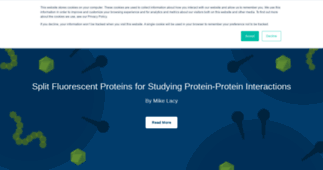Addgene
Enter a key term, phrase, name or location to get a selection of only relevant news from all RSS channels.
Enter a domain's or RSS channel's URL to read their news in a convenient way and get a complete analytics on this RSS feed.
Unfortunately Addgene has no news yet.
But you may check out related channels listed below.
[...] The field of synthetic biology has seen tremendous growth in recent years. At Addgene, synthetic biology deposits have grown exponentially, from just 2 plasmids in 2005 to 439 plasmids deposited [...]
[...] more interesting, we are working in a new technical discipline that nobody understands (synthetic biology), building a product no one has ever seen before (flowers that change color throughout the [...]
[...] Nicola Patron is Head of Synthetic Biology at the Sainsbury Laboratory, where she often feels more like an engineer than a biologist. [...]
[...] their company here. The first transgenic plant was engineered over 30 years ago, but plant synthetic biology is still in its infancy. A long timeline from transformation to testing and a lack of [...]
Nicola Patron is Head of Synthetic Biology at the Sainsbury Laboratory, where she often feels more like an engineer than a biologist. Their focus at t [...]
[...] In the world of fluorescent proteins and their use for imaging cell biology, Michael Davidson’s lab at Florida State University [...]
[...] contributed by Gal Haimovich of greenfluorescentblog. Be honest. Do you really know how fluorescent proteins glow? Fluorescent Proteins (FPs) were first discovered over 50 years ago, with the [...]
[...] . I find it ironic that we do all of our training as scientists (5-12 years worth!) with academic scientists who can’t help us learn about the nonacademic sphere where most of us will be working. It [...]
[...] vast collection of empty backbones that have been designed, tested, and published by academic scientists. To help you find the vector that fits your experiments, I've described below some of [...]
[...] With the meteoric rise of CRISPR technology, the ability to direct enzymes – from nucleases to transcription factors – to specific [...]
[...] both on-target efficacy and the potential for off-target activity, experiments utilizing CRISPR technology can provide a straightforward means of determining loss-of-function phenotypes for any gene [...]
[...] endocrine ligands. Nuclear Receptors and their Ligands NRs represent the largest family of transcription factors found in metazoans. The superfamily is comprised of 48 human and 49 murine members. NRs [...]
[...] rise of CRISPR technology, the ability to direct enzymes – from nucleases to transcription factors – to specific sequences of DNA has become commonplace. This ability has opened up [...]
[...] Patrick, Lianna Swanson, Julian Taylor-Parker We'd also like to thank our guest contributor: Gal Haimovich of greenfluorescentblog.org for helping us explain why things glow! Addgene's Plasmids 101 [...]
[...] This post was contributed by Gal Haimovich of greenfluorescentblog. Be honest. Do you really know how fluorescent proteins glow? [...]
[...] This post was contributed by Nikolai Braun and Keira Havens, co-founders of Revolution Bioengineering. Last year we started a company. [...]
[...] This post was contributed by Nikolai Braun and Keira Havens, co-founders of Revolution Bioengineering. Read their previous blog post [...]
[...] This post was contributed by Nikolai Braun and Keira Havens, co-founders of Revolution Bioengineering. Last year we started a company. Revolution [...]
[...] This post was contributed by Nikolai Braun and Keira Havens, co-founders of Revolution Bioengineering. Read their previous blog post about how they [...]
[...] was published in 1985, several studies utilized luciferase as a genetic reporter in plant and mammalian cells. Luciferase assays have since become a gold standard in gene expression analysis and a [...]
[...] of reasons, including but not limited to: helping to get difficult-to-deliver DNA into mammalian cells, increasing the efficiency of gene transduction, allowing for control over which cells [...]
[...] The field of synthetic biology has seen tremendous growth in recent years. At Addgene, synthetic biology deposits have grown exponentially, from just 2 plasmids in 2005 to 439 plasmids deposited [...]
[...] more interesting, we are working in a new technical discipline that nobody understands (synthetic biology), building a product no one has ever seen before (flowers that change color throughout the [...]
[...] Nicola Patron is Head of Synthetic Biology at the Sainsbury Laboratory, where she often feels more like an engineer than a biologist. [...]
Related channels
- I'd Rather Be Changing Diapers
-
Babyology
Modern finds for hip kids and parents
-
GetResponse Blog - Email Marketing Tips
Email marketing
-
SitePoint
Learn CSS | HTML5 | JavaScript | Wordpress | Tutorials-Web Development | Reference | Books and More
-
Armchair General Magazine – We Put YOU in Command!
All things military history!

